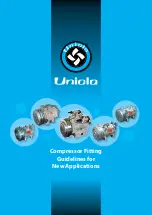
R-Series Electric
27
CQF3473 v.01
Operation & Service
April 17, 2018
Troubleshooting Chart
Always disconnect unit from power supply and relieve all pressure from air tank before performing any
maintenance. Failure to do so may result in personal injury or death. “Lock Out" or "Tag Out" all power
sources.
Never operate unit without belt guard in place.
Never use gasoline or flammable solvent on or around compressor unit. Explosion may result.
Symptom
Possible Cause(s)
Corrective Action
Motor will not start.
1. Main switch and fuses open.
2. Starter magnetic coils open.
3. Thermal overload tripped.
4. Defective pressure switch-contacts
will not close
5. Low voltage.
1. Check all fuses and switches. Check for
loose or faulty wires.
2. Check overload relay in starter. Reset
starter.
3. Reset starter. If starter trips
repeatedly, have electrical system
inspected by an electrician.
4. Repair or replace pressure switch.
Warning – Relieve tank pressure
before servicing.
5. Check with voltmeter. Be sure voltage
corresponds to unit specifications.
Starter trips repeatedly.
1. Improperly adjusted pressure switch.
2. Faulty check valve.
3. Incorrect fuse size or magnetic
starter coil.
4. Low voltage.
5. Defective motor.
1. Adjust or replace.
Warning – Relieve tank pressure
before servicing.
2. Clean or replace
Warning – Relieve tank pressure
before servicing.
3. Be sure that fuses and coils are
properly rated.
4. Check with voltmeter. Be sure voltage
corresponds to unit specifications.
5. Replace motor.
Tank pressure builds up slowly.
1. Air leaks.
2. Dirty air filter.
3. Defective compressor valves
6. Tighten fittings.
7. Clean or replace.
8. Install new valves.
Tank pressure builds up quickly.
1. Excessive water in tank.
1. Drain tank.
Discharge pressure relief valve
pops off while compressor is
running.
1. Wrong pressure switch setting.
2. Defective ASME relief valve.
1. Adjust to correct setting.
2. Replace valve.
Warning – Relieve tank pressure
before servicing.
Compressor will not unload
(Units with head unloaders)
1. Wrong pilot valve setting.
2. Defective pilot valve.
3. Lack of air to pilot valve.
1. Adjust to correct setting.
2. Replace pilot valve.
3. Open ball valve to pilot valve.
Excessive belt wear.
1. Pulley out of alignment.
2. Belts too tight or too loose.
1. Realign motor pulley.
2. Adjust belt tension.
Compressor runs hot.
1. Improper flywheel rotation
2. Defective compressor valves.
3. Dirty air filter.
4. Dirty cylinder and/or intercooler.
1. Check for correct rotation.
(Counter clockwise when viewed from
drive side.)
2. Install new valve plate assembly.
3. Clean or replace.
4. Clean cylinder fins and/or intercooler.






































